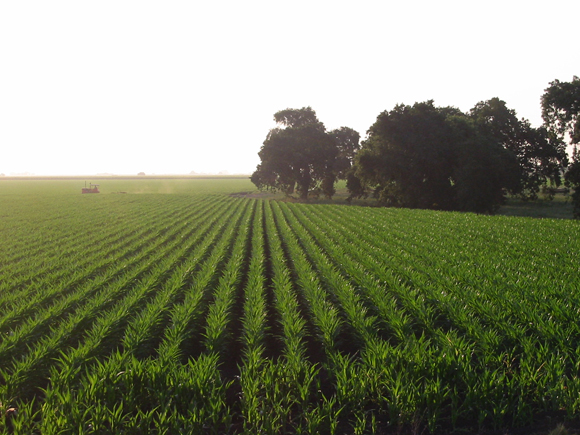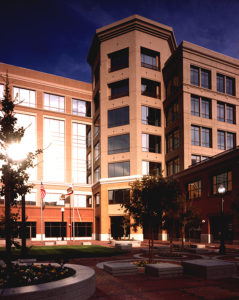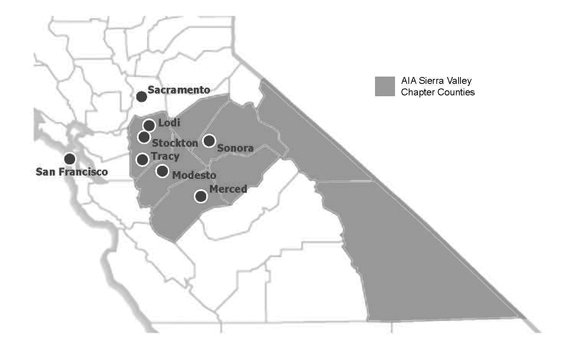
Relevance is the guiding theme of the AIA Sierra Valley (AIASV), located in the center of Northern California. How does such a small, unstaffed chapter stay relevant while surrounded by some of the largest AIA chapters in California? And how does a small professional chapter stay relevant in our community?
The AIASV has always struggled with a large geographical area (22,701 square miles) in seven counties, with only about sixty members, including associate, emeritus, and affiliate members. The AIASV is one of the last few unstaffed chapters: There are only six in California. Our chapter is surrounded by the AIA Central Valley to the north, with 715 members; and, to the west, by the AIA East Bay, with 590 members, and AIA San Francisco, with 1,935 members.
As an unstaffed chapter, the AIASV does not have the advantages of a chapter office, or the luxury of any devoted staff to take care of business. We receive our mail through a P.O. Box, and all our administrative responsibilities, including correspondence, meeting minutes, phone calls, website development, and event planning, are handled by one of ten board members.
The chapter is governed by a board in which the director succeeds to president and then AIACC representative, with each board member typically serving seven years. Such a large time commitment causes burnout. We have “recycled” some board members for up to three terms.
The question of relevance arises: Why not join forces with the neighboring staffed chapters and abandon the effort that is draining the enthusiasm for all who want to participate? That can be answered in one word: Regionalism. Surrounding chapters cannot deal directly with the community issues that affect our chapter.
The Need for Smart Growth
Most of the Sierra Valley Chapter counties will experience a population explosion in the next few years. From an economic standpoint, such growth will bring much needed work for the architectural community. But, as chapter members, we also serve as trustees of the land. This growth will diminish the nation’s food pantry.
California is the nation’s top agricultural producer; 2004 cash receipts represented 13.2 percent of the U.S. total and were more than Texas and Iowa (the second and third leading states) combined. Within our chapter area, we have approximately 1.5 million people, with most cities having a population of less than 100,000. The counties within the chapter are ranked nationally as follows: no. 5 in production of grapes; no. 3, 5 and 6 in production of tomatoes; no. 1, 4, and 8 in production of peaches; no. 8 and 9 in production of poultry; and no. 9 in production of plums and prunes.
The inevitable growth in our area is at the sacrifice of prime agricultural land: When the land is depleted, so is its ability to feed a nation. The obvious answer to this problem is the definition of smart growth: high density. Build densely and save the farmland.
Mark Hart, president of the AIA Sierra Valley Chapter, thinks the Central Valley’s ongoing population increase is a major issue. “The increase is challenging each affected community’s ability to keep pace with housing needs, strained infrastructure, and declining transportation efficiency,” he says. “Solutions such as higher density housing to revitalize inner-city areas and high-speed rail service are in order.”
“Recycled” board member and past president Cooper Kessel, AIA, who lives out of the agricultural zone, believes that growth can be managed: “New growth in central/northern California should be in the foothills to preserve the state’s agriculturally productive Central Valley.”
The population growth is not necessarily resulting in more trained professionals capable of solving such issues, Hart said. In fact, the number of new architects has declined in recent years. “Consequently, unstaffed AIA chapters struggle just to stay alive. Human resources are badly needed, and, unfortunately, no immediate solution is available.”
Among the challenges the AIASV chapter faces are these:
- Our chapter wants “smart growth,” but how does that occur when the farmer can make more money selling the farmland to a developer than farming it? Cities are growing based on the dollar, thus making long-range commitments to developers for thousands of homes beyond their city boundaries, in exchange for built infrastructure now.
- Our chapter wants high density, but how does that occur when it is more expensive to build high density than create sprawl on farmland? How many high-rise housing projects do you see in an alfalfa field? Cities within our chapter have routinely rezoned high-density land for developers in favor of low-density, single-family homes.
- Our chapter wants to relieve traffic congestion, but how does that occur when our cities are twenty miles or more apart, separated by farmland, a significant percentage of residents commute to jobs outside of their city, and tens of thousands commute to jobs outside the chapter?
- Our chapter wants transportation hubs, but how does that occur when transportation within most cities is limited to a small bus service, and the major cities within our chapter are linked by two major freeways?
Chapter members often complain that other people ultimately make decisions affecting the chapter area. These others argue that we as architects, within our small chapter and small communities, are not broad based enough to understand the “big picture.” Policy makers, from state government, transportation organizations, surrounding county and city governments, and sometimes even within the AIACC itself, all have opinions about growth, but our chapter members are rarely involved.
Our chapter not only lacks a physical address but also a representative body. We do have the experience and intelligence to make decisions, but we lack power as a single voice. Thus we miss the ability to be involved in, invited to, or even made aware of the discussion: We become irrelevant in our own backyard.

another multi-story office building. Courtesy of LPA Sacramento, Inc.
Transportation and Redevelopment
Our chapter’s growth does have bright spots. In 1999, the AIACC and the Great Valley Project in Sacramento sponsored an international competition titled “Housing the Next 10 Million,” to see what the future holds for housing within the Central Valley. The AIASV chapter involvement with the competition was limited, but the contest started the dialogue for area growth.
A crucial component to smart growth is planned transportation. A commuter ACE train travels from Stockton through Tracy to San Jose, taking valley residents to their jobs in the Bay Area. The jobs are out of the chapter, and the train does not serve as transportation within the chapter. But a successful transportation spine has been established. And in the true spirit of infill development, both Stockton and Modesto, the two major cities within our chapter with 200,000- plus population, are seeing significant redevelopment of their downtowns, utilizing existing land, and spending money on infrastructure and density that will serve their growing communities. DCA in Stockton and Pacific Design Associates in Modesto, two architectural firms in the Chapter, were influential contributors to the design for redevelopment in their respective cities.

The Need for Regional Involvement
We all agree in the AIASV Chapter that a grand vision is necessary for the foreseeable growth in our area. Our members approach the management of growth by practicing good design in their communities and staying involved with public and private agencies in their cities. Our growth demands the attention of outsiders. We are losing not only our farmland but that of the nation.
If every city around our chapter increased their density by 15 percent (the average growth of the valley), and made the housing affordable to the city’s working class, there would not be such a dramatic population explosion in our chapter, and the nation’s farmland would be safe. But until that happens, the AIASV members need to find a seat at that all-important table to make the “big” decisions about growth in our own communities.
The AIASV Board will stand strong and stay relevant to support unstaffed chapters in the AIACC leadership. The AIASV Chapter will continue to “recycle members” if necessary to remain a relevant organization uniquely representative and distinct from the surrounding AIA chapters. AIASV members will continue to be relevant in community organizations, trying to impart wisdom in small doses, as the nodes of the Chapter’s cities grow closer together.
While the AIASV chapter needs to be involved in regional decisions, members share a longstanding, grassroots commitment to their communities, as demonstrated below:
- Mike Pratt, AIA: City of Modesto Planning Commission for nine years; Fire Department Long Range Planning Committee; City of Modesto Board of Zoning Adjustment for three years; Citizens Redevelopment Advisory Committee for five years, Citizens Housing and Community Development Committee.
- Tim Dearborn, AIA: City of Stockton’s Cultural Heritage Board for three years; Residential Revival Subcommittee for Midtown Advisory Group (Stockton) for two years.
- Bob Degrasse, AIA: Howard Training Center for five years.
- Ron Beasley, AIA: Advisory Council of the Salvation Army.
- Mike Navarro, AIA: Stanislaus County YMCA Board for six years; Citizens Redevelopment Advisory Committee for fourteen years; Stanislaus County Planning Commission for two years; City of Modesto Board of Zoning Adjustments for three years; Building Standards Commission Advisory Committee on Health Care for five years; Hospital Building Safety Board.
- Jim Rende, AIA: Tuolumne County Board of Appeals for two years.
- Don Phillips, AIA: Board Member of North San Joaquin Valley Health Systems Agency for two years; Class Member of Leadership Modesto for two years; Board Member of Steering Committee for Leadership Modesto for two years; Chairman of Leadership Modesto for two years; Board of Trustees Member of McHenry Mansion Foundation for six years.
- Bob Machado, AIA: Founder of Sponsors of Musical Enrichment.
- Ted Brandvold, AIA: City of Modesto Board of Zoning Adjustment for two years; City of Modesto Planning Commission for one year.
- Thom Torvend, AIA: Modesto Landmark Preservation Commission for five years.
Author Christina D. B. Frankel, AIA, is a licensed architect and Project Manager in the Housing Studio at the multi-disciplinary firm LPA Sacramento Inc. She is currently on the AIACC Board of Directors and has served on the AIASV board for nine years.
Originally published 3rd quarter 2006 in arcCA 06.3, “Preserving Modernism.” Re-released in arcCA DIGEST Season 11, “The Valley.”






